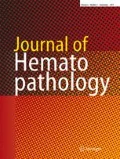An 81-year-old patient presents with left-sided weakness in the setting of bitemporal ischemic stroke and right intraparenchymal temporal hemorrhage. He was found to have a fever of 39.2 °C and shock requiring vasopressor support. Laboratory investigations showed a white blood cell (WBC) count of 7.3 × 103/μL with 40% bands, thrombocytopenia of 97 × 103/μL, and elevated AST. Due to a history of ischemic cardiomyopathy, he underwent right heart catheterization revealing elevated biventricular filling pressures and low cardiac index. The patient was started on intravenous diuretics and broad-spectrum antibiotics for the management of combined septic and cardiogenic shock. He continued, despite treatment, to have recurrent fevers with worsening shock and hypoxemia. His platelet count continued to drop (27 × 103/μL) and his WBC count increased to 23 × 103/μL. Further history revealed repeated tick bites during outdoor activities on recent travel to New York State. The peripheral blood smear (Fig. 1) showed intracytoplasmic basophilic inclusions (arrowhead) in the neutrophils, suggestive of Anaplasma phagocytophilum morulae. The patient was started on doxycycline to treat presumptive anaplasmosis and Lyme disease. Serologic testing came back positive for Lyme disease IgM, IgG, and immunoblot, while PCR was confirmatory for Anaplasma phagocytophilum. Despite improvement in fever, patient succumbed to his illness due to severe cardiogenic shock. Early examination of peripheral blood smear is important when Tick-borne disease is suspected. The detection of intracytoplasmic morulae in granulocytes is highly specific for anaplasmosis, but also relatively insensitive to rule out the disease. Evaluation of blood smear is also recommended in suspected babesiosis and ehrlichiosis [1, 2]. In contrast to Anaplasma, Ehrlichia sp. typically infect monocytes and not granulocytes. Treatment should be initiated if anaplasmosis is suspected and should not be delayed for confirmatory testing.
Data availability
All data underlying the results are available as part of the article and no additional source data are required.
References
Sanchez E, Vannier E, Wormser GP, Hu LT (2016) Diagnosis, treatment, and prevention of lyme disease, human granulocytic anaplasmosis, and babesiosis: a review. JAMA 315(16):1767–1777. https://doi.org/10.1001/jama.2016.2884
Berghoff W (2012) Chronic lyme disease and co-infections: differential diagnosis. Open Neurol J 6:158–178. https://doi.org/10.2174/1874205x01206010158
Author information
Authors and Affiliations
Contributions
AM: data acquisition and literature review. AA: data acquisition and manuscript writing. BE: pathology review and manuscript writing.
Corresponding author
Ethics declarations
Ethical approval
For this type of study, formal consent is not required.
Consent to participate
For this type of study, informed consent is not required.
Consent for publication
Verbal consent obtained from patient’s grandchild (closest relative).
Conflict of interest
The authors declare no competing interests.
Additional information
Publisher's note
Springer Nature remains neutral with regard to jurisdictional claims in published maps and institutional affiliations.
Rights and permissions
Springer Nature or its licensor (e.g. a society or other partner) holds exclusive rights to this article under a publishing agreement with the author(s) or other rightsholder(s); author self-archiving of the accepted manuscript version of this article is solely governed by the terms of such publishing agreement and applicable law.
About this article
Cite this article
Mahmoud, A.A., Abdelhay, A. & Eltaher, B. Anaplasmosis and Lyme disease. J Hematopathol 16, 57–58 (2023). https://doi.org/10.1007/s12308-022-00525-4
Received:
Accepted:
Published:
Issue Date:
DOI: https://doi.org/10.1007/s12308-022-00525-4


